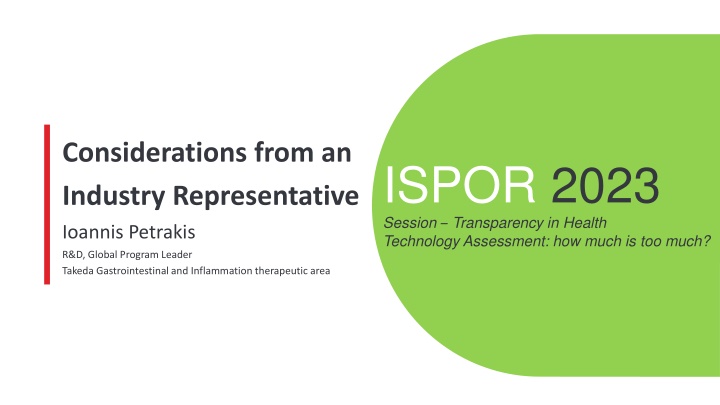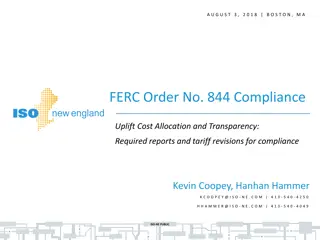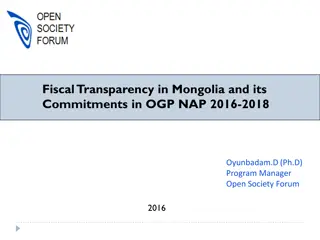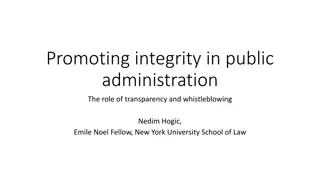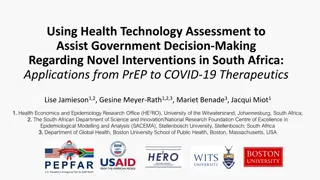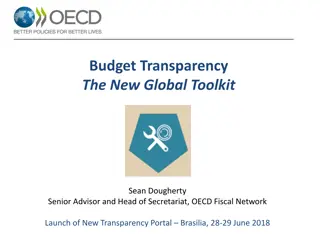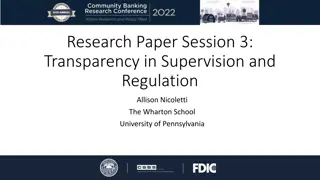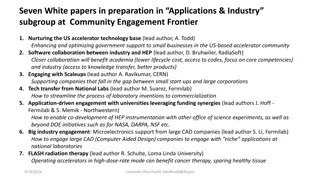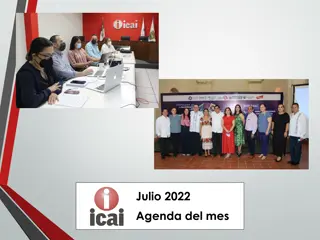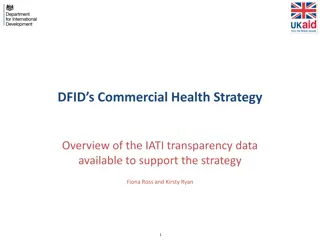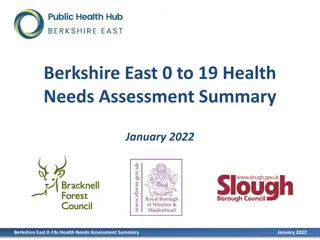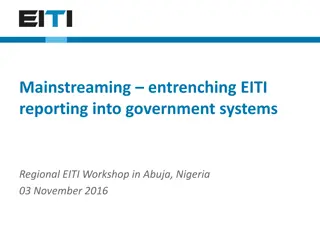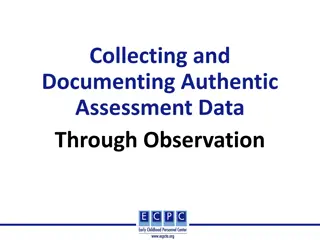Transparency in Health Technology Assessment: Industry Insights by Ioannis Petrakis
Ioannis Petrakis, a Global Program Leader at Takeda, shares considerations on data transparency in health technology assessment, highlighting the importance of collaboration between HTAs, patients, and industry. He emphasizes Takeda's commitment to openness in clinical data and the need for thoughtful implementation of changes to benefit science and patient care.
Download Presentation

Please find below an Image/Link to download the presentation.
The content on the website is provided AS IS for your information and personal use only. It may not be sold, licensed, or shared on other websites without obtaining consent from the author.If you encounter any issues during the download, it is possible that the publisher has removed the file from their server.
You are allowed to download the files provided on this website for personal or commercial use, subject to the condition that they are used lawfully. All files are the property of their respective owners.
The content on the website is provided AS IS for your information and personal use only. It may not be sold, licensed, or shared on other websites without obtaining consent from the author.
E N D
Presentation Transcript
Considerations from an Industry Representative Ioannis Petrakis ISPOR 2023 Session Transparency in Health Technology Assessment: how much is too much? R&D, Global Program Leader Takeda Gastrointestinal and Inflammation therapeutic area
Introduction We thank NICE for bringing together stakeholders to discuss this important topic We welcome the joint venture between HTAs, patients and Industry to contribute to the public dialogue around the process of confidentiality and clinical data transparency Working in partnership in implementing changes Ideally, changes to the confidentiality guidance from HTAs will reduce workload burden on both HTA bodies and Pharmaceutical Industry, whilst striving for timely and appropriate information sharing with the patient community We would like to take this opportunity to highlight some considerations We all share the same intentions around data transparency to advance science and help patients, while protecting patient access. While introducing change, we need to observe how ICMJE statement will be implemented and what other risks may arise Important note All opinions and information herein are mine and may not necessarily represent the position of my company, including its affiliates in the UK, the USA and Canada, or any other Pharmaceutical Industry association or member across the world HTA, health technology assessment; NICE, National Institute for Health and Care Excellence; ICMJE, International Committee of Medical Journal Editors. 2
Firstly our company is committed to publishing all clinical data in open access format Takeda Clinical Study Transparency Policya Takeda is committed to transparency and integrity in its clinical research. Takeda has been and continues to be committed to complying with all laws and regulations related to the registration and disclosure of Takeda- sponsored clinical study information. Takeda is dedicated to the timely registration of clinical studies, communication of clinical study result summaries, and publication of our company sponsored clinical research. Takeda supports pharmaceutical industry's joint initiatives relating to increased clinical trial transparency Takeda only publishes in Open Access Journalsb Takeda s commitment to transparency and the discoverability and accessibility of Takeda research, all STM manuscripts resulting from Takeda- sponsored research, regardless of research type, audience, and language, are required to be submitted to journals that offer public availability via Open Access We include relevant statements upon submission of CT manuscripts to a journal for publicationb The datasets, including the redacted study protocol, redacted statistical analysis plan, and individual participants data supporting the results reported in this article, will be made available within three months from the initial request, to researchers who provide a methodological sound proposal. The data will be provided after its de-identification in compliance with applicable privacy laws, data protection and requirements for consent and anonymization. 3 a Available at, https://www.takeda.com/en-gb/corporate-responsibility/transparency-disclosures/clinical-trials-and-results; b Takeda standards, Data on File. CT, clinical trial; EFPIA, European Federation of Pharmaceutical Industries; PhRMA, Pharmaceutical Research and Manufacturers of America; STM, Scientific, Technical and Medical.
Secondarydata requests may hinder HTA submissions due to company workload and negotiations between requesting affiliate and data owner HTA bodies frequently request further clinical data analyses Post-hoc/exploratory analyses, new RWD analysis, unplanned subgroups, PSP data etc. Global teams will need to complete all analyses in a publication ready manner Illustrative 2 years from study completion to publication AIC/CIC AIC/CIC RCT/CSR HTA submission Data requests Decision Pubs plan Of the 1336 clinical trials published during 2009, median time to publication from study completion was 21 months (IQR, 13 32 months)1 Of 196 drug-evaluating clinical trials approved by a Spanish Ethics Committee between 1997 and 2004, time to publication from study closure was 2.09 years (95%CI 1.61 2.56) for studies with results classified as positive2 Regulatory AIC, academic in confidence; CI, confidence interval; CIC, commercial in confidence; CSR Clinical Study Report; HTA, health technology assessment; IQR, interquartile range; PSP, Patient Support Program; QC, quality control; RCT, randomized controlled trial; RWD, real-world data. 1. Ross JS, Mocanu M, Lampropulos JF, Tse T, Krumholz HM. Time to Publication Among Completed Clinical Trials. JAMA Intern Med. 2013;173(9):825 828. doi:10.1001/jamainternmed.2013.136 2. Su P, Su JM, Montoro JB. Positive outcomes influence the rate and time to publication, but not the impact factor of publications of clinical trial results. PLoS One. 2013;8(1):e54583. doi: 10.1371/journal.pone.0054583. Epub 2013 Jan 30. 4
In most cases, guaranteeing confidentiality simplifies data release process, but does not solve for additional Pubs and quality control requirements HTA bodies frequently request further clinical data analyses Post-hoc/exploratory analyses, new RWD analysis, unplanned subgroups, PSP data etc. Global teams will need to complete all analyses in a publication ready manner Illustrative ~2 years from study completion to publication RCT/CSR HTA submission Data requests Decision Pubs plan QC Regulatory Update pubs plan (biostats, IP, medical, legal etc) Patient confidentiality AIC, academic in confidence; CIC, commercial in confidence; CSR Clinical Study Report; IQR, interquartile range; HTA, health technology assessment; IP, Intellectual property; PSP, Patient Support Program; QC, quality control; RCT, randomized controlled trial; RWD, real-world data. 5
What is the problem we cannot afford to create? Illustrative Publication considerations: Congress presentations falling into embargo restrictions Journals that do not enforce ICMJE guidelines Delayed patient access to novel therapies More mark-up restrictions may result in lengthier negotiation between affiliate and HTA or Global team to gain permission to make evidence publicly available if it is fundamental to committee decision making Streamlined redactions for HTA submissions Delays releasing clinical data Company considerations: Material information and IR considerations QC findings or regulatory needs that lead to data improvements after CSR CSR, Clinical Study Report; ICMJE, International Committee of Medical Journal Editors; QC, Quality Check; IR, Investor relations 6
What else could help? Simplification of confidentiality, dialogue and stakeholder partnership ICMJE Dialogue Open dialogue between HTA bodies, industry, the public and regulatory agencies on redacting principles Sponsors Inter-company alignment on what has been made public by HTA bodies or regulatory agencies Training Alignment Aligned confidentiality principles across different HTA bodies, ideally with similar enforcement methodologies and timelines Confidentiality Streamlined confidentiality process, allowing for certain redactions on necessary information (final decision making stays with sponsor) Continued monitoring of how the ICMJE statement gets implemented? Understand position of non-ICMJE publishers Training for all in partnership with participating HTA bodies Above all, what is meaningful to patients? HTA, health technology appraisal; ICMJE, International Committee, of Medical Editors; NICE, National Institute for Health and Care Excellence. 7
ISPOR 2023 Session Transparency in Health Technology Assessment: how much is too much? Thank you https://www.linkedin.com/in/ioannis-petrakis-takeda
